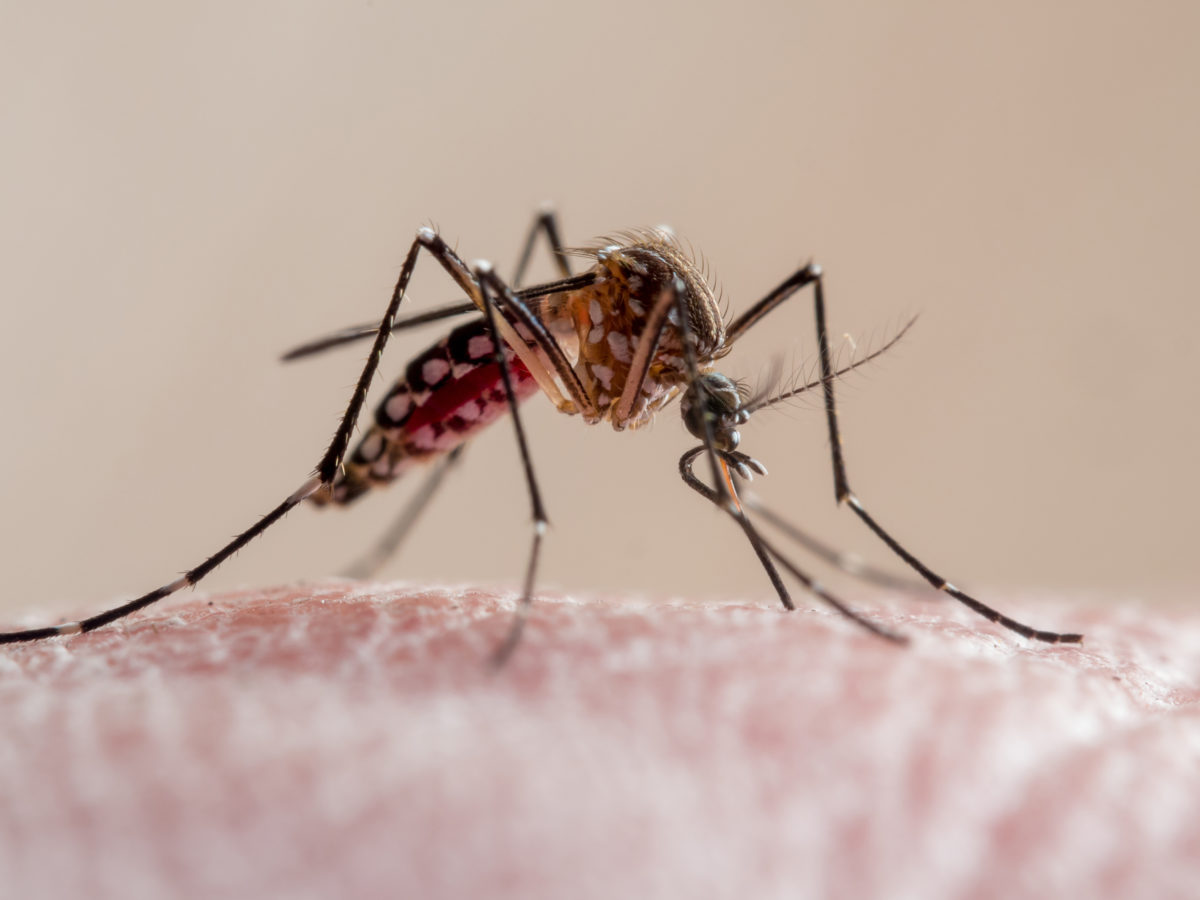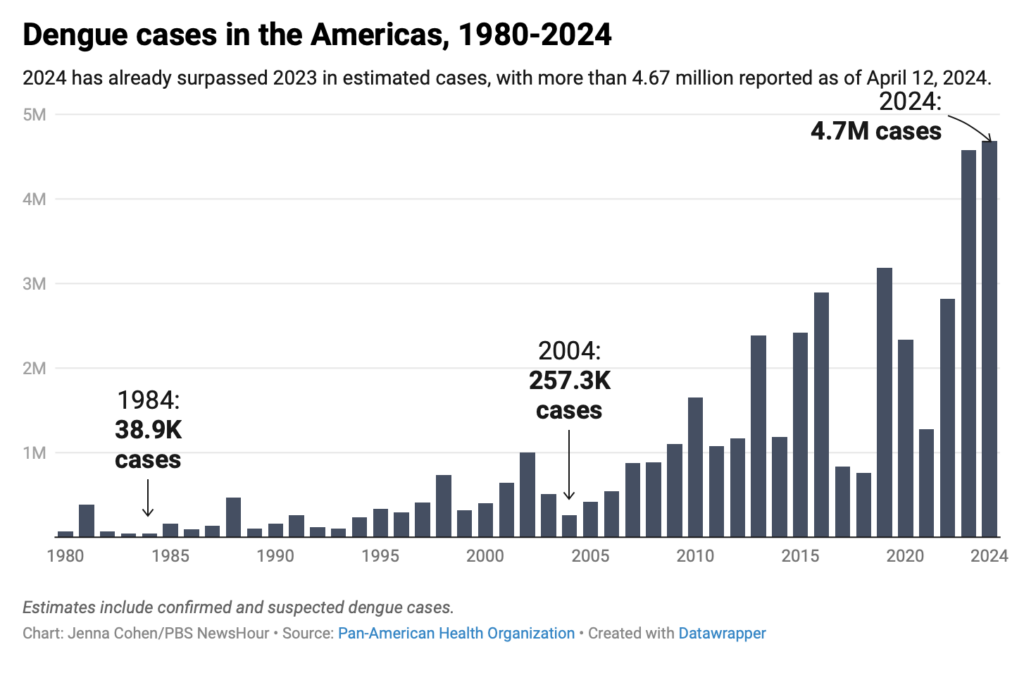
What you need to know about the latest outbreak of dengue fever
Health Apr 12, 2024 2:42 PM EDT; PBS HOUR by Laura Santhanam
Roughly 4.7 million people have been infected with dengue fever so far in 2024, an explosion of cases centered in Latin America and the Caribbean that experts warn could grow.
“We’re seeing a worrisome trend of expansion and increasing circulation of the virus at the global scale,” said Dr. Gonzalo Vazquez-Prokopec, a professor at Emory University who researches the intersection of ecology, epidemiology and global health.
Heavy precipitation from El Nino and the ongoing effects of human-driven climate change have fostered conditions in which mosquitoes that carry the disease can thrive. Populations in more regions of the world are being exposed to dengue as summers grow longer and hotter summers, especially in urban areas that are home to Aedes aegypti, the type of mosquito that transmits the virus, Vazquez-Prokopec said.
In late March, Puerto Rico issued a public health emergency after about 600 people were confirmed to have dengue fever, leading to hundreds of hospitalizations. Puerto Rico has declared an epidemic following a sharp rise in dengue cases.
People living in and traveling to these areas can take precautions to prevent exposure and further transmission. While vaccines exist to prevent the worst outcomes of dengue fever, there is no cure if someone gets sick.
How many cases have been identified in this outbreak?
So far in the first four months of 2024 alone, more than 4.6 million people in the Americas are estimated to have been infected with dengue fever, said Thais Dos Santos of Pan-American Health Organization (PAHO). That amounts to more cases than were recorded during all of 2023, she said.

How is dengue fever transmitted?
The dengue virus is carried in the gut of female mosquitoes. When the insect bites an infected person and then feeds on someone else, it can spread the infection to that person.
People cannot directly spread dengue to each other.
Places with unreliable access to clean drinking water are particularly vulnerable in part because people may need to collect and store water in vessels, which become the perfect environment for mosquitoes to breed.
What are the symptoms of dengue fever?
Roughly two-thirds of people who are infected with dengue show no signs for disease, Dos Santos said.
But for those who do, symptoms typically develop within two weeks. People most commonly complain of sudden high fever and headache. The illness can be painful, and a person’s condition can deteriorate rapidly, Dos Santos said. Symptoms include muscle and joint pain, fatigue, nausea and vomiting.

In more extreme cases, intense abdominal pain and bleeding gums can be signs of plasma leakage and require immediate medical attention.
Who is at risk of severe dengue infections?
There are four known serotypes, or strains, of the dengue virus. Infection with one strain typically leaves the person who was sick with lifelong immunity, but only from that strain, said Dr. Anna Durbin, who directs the Center for Immunization Research at Johns Hopkins University.
If the person gets infected again with a different strain, that can launch a process called antibody-dependent enhancement, where the immune system’s collection of antibodies “acts as a chaperone,” Durbin said, escorting the virus throughout the body. The person can become extremely ill and may require hospitalization.
Because first-time infections often result in undetected cases with no symptoms or mild ones, many people do not realize they have been exposed. It is upon the second bite and introduction of a different strain that people can get really sick, Vazquez-Prokopec said.
“If there’s an outbreak going on, the best thing to prevent severe dengue is to go to the doctor as soon as you feel symptoms,” he said.
What treatment is available for dengue fever?
While there is no cure for dengue fever, people experiencing symptoms of infection can work with their health care provider to manage them. This may include taking medication to relieve pain, increasing fluid intake to prevent dehydration and getting plenty of rest.
What can be done to prevent dengue fever?
Use mosquito repellant and wear long-sleeved shirts and long pants in areas where dengue is spreading, Vazquez-Prokopec said. Mosquitoes that transmit dengue are day biters, so mosquito nets over beds are a less effective prevention measure (although these fine-mesh nets are recommended to slow the spread of other mosquito-borne illnesses, such as malaria).
“Make sure you don’t accumulate standing water in or around your house,” Dos Santos said.
In addition to removing standing water when possible, Vazquez-Prokopec said it is important that communities spray for mosquitoes and households use mosquito-repellent coils to deter the insects from feeding on residents.
He added that when traveling to an area where dengue fever is endemic, it’s a good idea to wear mosquito repellant for the next three or four days after returning home to prevent introduction of the disease to your community.
One prevention method that has gained attention is the introduction of male mosquitoes infected with the bacteria Wolbachia. When those mosquitoes mate with female mosquitoes, the resulting eggs do not hatch, thus stopping the possible spread of any diseases the insects may carry.
“We cannot give up on vector control,” Vazquez-Prokopec said.
Why is this recent outbreak so widespread?

How climate change affects dengue fever infection rates
The rapid spread of dengue fever in recent months provides a real reminder of the ripple effects of human-driven climate change, said Thais Dos Santos with the Pan-American Health Organization.
As temperatures and sea levels rise, along with fundamental shifts in climate, mosquitoes can thrive in more places, particularly in urban areas.
“We think of climate change as an issue of melting ice caps, but this is a real tangible health impact of climate change,” Dos Santos said. “We can’t approach this from the health sector alone. It really requires an all-of-society approach to take care of this in a systemic way.”
Dengue cases declined between 2016 and 2018 but began an uptick before the COVID pandemic, Durbin said. COVID lockdowns prevented people (and the virus) from circulating, meaning fewer people were getting bitten or had a chance to develop immunity.
But a recent surge of global travel, coinciding with an El Nino year, has translated to a dramatic increase in confirmed and suspected dengue infections, Durbin said.
“In the past two years, it’s exploded,” she said.
More than 5 million people have developed dengue fever since early 2023, according to estimates released by the World Health Organization in January, and the Americas “reported the largest proportion of the global burden.” Confirmed and suspected cases in the Western Hemisphere have more than quadrupled over the last five years.
Will the continental U.S. experience a significant outbreak?
For now, most people in the continental U.S. do not need to be concerned about dengue fever, Dos Santos said. During warm weather, a lot of people spend time inside screened-in houses with air conditioning, she said. When they are thirsty, they turn a faucet for water and generally do not need to store rainwater. But that type of infrastructure is not guaranteed in parts of the world that struggle more regularly with dengue fever, she said.


Leave a Reply